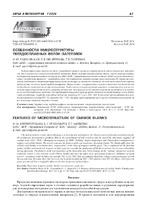| dc.contributor.author | Ходосовская, О. Ю. | |
| dc.contributor.author | Овсянникова, Л. В. | |
| dc.contributor.author | Гапеенко, Т. В. | |
| dc.coverage.spatial | Минск | ru |
| dc.date.accessioned | 2024-04-11T12:00:01Z | |
| dc.date.available | 2024-04-11T12:00:01Z | |
| dc.date.issued | 2024 | |
| dc.identifier.citation | Ходосовская, О. Ю. Особенности микроструктуры твердосплавных волок-заготовок = Features of microstructure of carbide blanks / О. Ю. Ходосовская, Л. В. Овсянникова, Т. В. Гапеенко // Литье и металлургия. – 2024. – № 1. – С. 47-50. | ru |
| dc.identifier.uri | https://rep.bntu.by/handle/data/141815 | |
| dc.description.abstract | Задача современных науки и техники – разработка новых и улучшение характеристик уже используемых материалов для изготовления конкурентоспособной продукции. Ввиду переориентации рынков сбыта, поиска альтернативных поставщиков твердосплавного инструмента ОАО «БМЗ – управляющая компания холдинга «БМК» начало сотрудничество с китайскими фирмами – производителями (поставщиками) твердосплавных волок-заготовок. В статье рассмотрены особенности микроструктуры таких волок-заготовок, в частности показано, что они отличаются от серийно применяемых по классу зерна карбида вольфрама. Марки сплава с наноразмерным зерном используют для достижения необходимой стойкости волок при эксплуатации. Особенности в микроструктуре твердого сплава повлекли также изменение параметра «плотность» в сторону уменьшения, что присуще всем китайским волокам-заготовкам и не влияет на их эксплуатационные свойства. Для предотвращения роста зерна во время спекания в твердосплавные смеси добавляют ингибиторы – карбиды переходных металлов, например VC, Cr2C3, NbC, TaC. В последнее время наблюдается тенденция введения в сплавы WC–Co присадок TaC + TiC, которые предотвращают рост зерна и незначительно влияют на все остальные свойства твердых сплавов. | ru |
| dc.language.iso | ru | ru |
| dc.publisher | БНТУ | ru |
| dc.title | Особенности микроструктуры твердосплавных волок-заготовок | ru |
| dc.title.alternative | Features of microstructure of carbide blanks | ru |
| dc.type | Article | ru |
| local.description.annotation | The task of modern science and technology is to develop new and improve the characteristics of already used materials for the production of competitive products. Due to the reorientation of sales markets and the search for alternative suppliers of carbide tools, OJSC “BSW – Management Company of “BMK” Holding” began cooperation with Chinese firms-manufacturers/ suppliers of carbide blanks. The article examines the features of the microstructure of carbide blanks. The blanks differ from the serially used blanks in microstructure, in particular, in the class of tungsten carbide grain. This is explained by the fact that grades of alloy with nanoscale tungsten carbide grain are used for the production of blanks to achieve the necessary durability during operation. The features in the microstructure of the hard alloy also led to changes in the “density” parameter towards reduction, which is also inherent in all Chinese blanks and does not affect their operational properties. Inhibitors of grain growth – transition metal carbides, for example, VC, Cr2C3, NbC, TaC are added to hard alloy mixtures to prevent grain growth during sintering. Recently, there has been a trend towards introducing TaC + TiC additives into WC–Co alloys, which prevent grain growth and have a negligible effect on all other properties of hard alloys. | ru |

